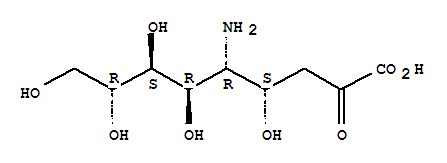Base Information
Edit
- Chemical Name:(4S,5R,6R,7S,8R)-5-amino-4,6,7,8,9-pentahydroxy-2-oxononanoic acid
- CAS No.:114-04-5
- Molecular Formula:C9H17 N O8
- Molecular Weight:267.23
- Hs Code.:
- UNII:L4866H38XY
- DSSTox Substance ID:DTXSID20895056
- Nikkaji Number:J719.759D
- Wikidata:Q27891805
- Metabolomics Workbench ID:51483
- Mol file:114-04-5.mol
Synonyms:keto-neuraminic acid;(4S,5R,6R,7S,8R)-5-amino-4,6,7,8,9-pentahydroxy-2-oxononanoic acid;L4866H38XY;(2R,4R,5R,6R)-5-AMINO-2,4-DIHYDROXY-6-(1,2,3-TRIHYDROXYPROPYL)OXANE-2-CARBOXYLIC ACID;NEURAMINIC ACID [MI];SCHEMBL3404499;CHEBI:27851;DTXSID20895056;5-amino-3,5-dideoxy-Neuraminic acid;Q27891805;5-amino-3,5-dideoxy-d-glycero-d-galacto-nonulosonic acid



